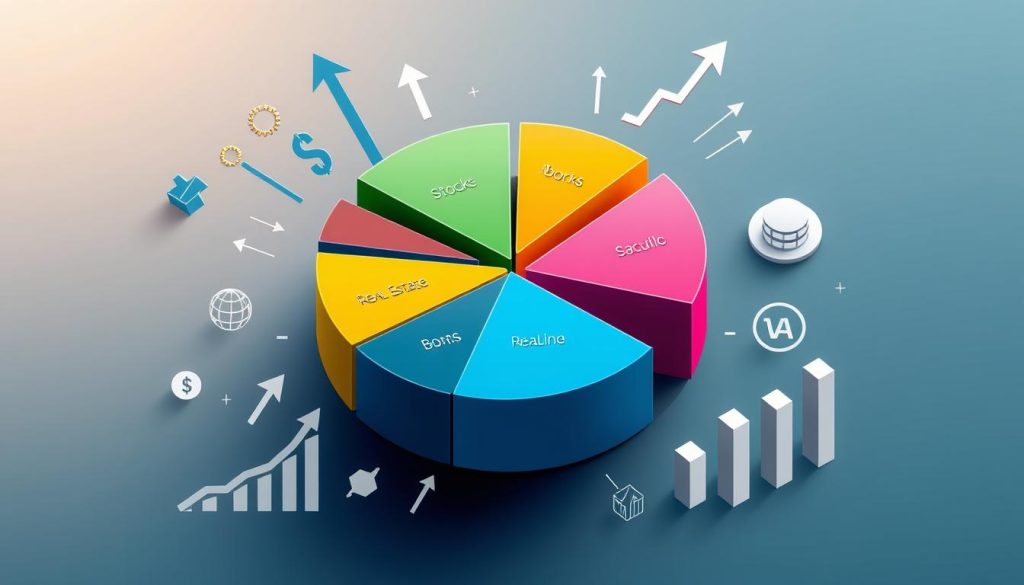For financial experts, knowing how to manage risk is key to creating successful1 investment portfolios. It’s important to understand the difference between systemic and non-systemic, or idiosyncratic, risk1. Idiosyncratic risk is the risk tied to a specific asset, like a stock. Systemic risk affects all investments in a class, like interest rates or inflation1.
When dealing with mutual funds, it’s vital to know these risk types1. To lower idiosyncratic risks, spread out your investments. Most of the risk that individual stocks face comes from these unique factors1. By investing in different assets that don’t move together, you can reduce these risks1. Systemic risk, however, is tied to big economic changes and is important to understand for investment planning1.
Key Takeaways
- Idiosyncratic risk is the inherent risk tied to a specific asset, while systemic risk impacts all investments in a class.
- Diversification is a key strategy for reducing idiosyncratic risks in investment portfolios.
- Common forms of idiosyncratic risk in mutual funds include operating strategies, financial policies, corporate culture, and investment strategy.
- Systemic risks, such as changes in interest rates or inflation, can significantly affect the market and economy.
- Understanding both idiosyncratic and systemic risks is crucial for successful mutual fund portfolios.
Understanding Idiosyncratic Risk and Its Impact on Mutual Funds
Investing in mutual funds means understanding the risks involved. Idiosyncratic risk, or unsystematic risk, is a key one. It’s the risk tied to a specific asset or investment, not the market’s overall trend2. This risk is crucial for mutual fund investors, as it can greatly affect their investment’s performance.
Defining Idiosyncratic Risk
Idiosyncratic risk is unique to a particular investment and doesn’t follow the market’s trend3. It comes from a company’s strategies, financial policies, and more2. This risk is also known as unsystematic risk. It’s tied to a company or a small group, unlike the broader economy and markets3.
Idiosyncratic Risk vs. Systemic Risk
Systemic risk, or market risk, affects the whole market or portfolio3. Things like interest rate changes or economic shifts are examples3. Unlike idiosyncratic risks, which can be reduced by spreading out investments, systemic risks are harder to control because they’re not tied to one investment3.
Common Forms of Idiosyncratic Risk in Mutual Funds
Mutual funds face different kinds of idiosyncratic risk, such as:
- Business risk: Risks from a company’s operations, like product failures or supply chain issues2.
- Financial risk: Risks from a company’s financial setup, like too much debt or liquidity problems2.
- Operational risk: Risks from a company’s internal workings, like cyber attacks or mistakes2.
- Strategic risk: Risks from a company’s big decisions, like bad mergers or failed growth plans2.
- Legal or regulatory risk: Risks from law or policy changes that affect a company2.
Knowing and managing idiosyncratic risk is key for mutual fund investors. It helps them create a diverse portfolio and lessen the effect of these risks on their investments23.
“Diversification can generally mitigate idiosyncratic risk in an investment portfolio.”2
Systematic Risk: Navigating Market, Interest Rate, and Inflation Risks
Understanding the risks that can affect your mutual fund investments is key for investors. Systematic risk, or market risk, is the risk that affects the whole market or a whole portfolio4. This risk is hard to predict and often seen as hard to avoid4.
Market Risk and Its Impact on Mutual Funds
Market risk is a big source of systematic risk. It happens when security prices move together, affecting mutual fund performance4. Mutual funds’ risk level is shown by their beta, which compares their volatility to the market’s4. A beta over one means higher risk, while under one means lower risk4.
Interest Rate Risk and Its Implications for Mutual Funds
Interest rate risk is another systematic risk. It comes from changes in market interest rates. This mainly affects fixed-income securities, as bond prices go down when interest rates go up5. Investors in mutual funds with lots of fixed-income assets should watch out for how interest rates change.
Mitigating Purchasing Power Risk in Mutual Fund Investments
Purchasing power risk, or inflation risk, can also hurt mutual fund investments5. Inflation makes money worth less, which can hurt fixed-income investments. To fight this risk, investors might add assets like real estate or commodities to their mutual funds.
Knowing about systematic risks and their effects on mutual funds helps investors plan better. This way, they can manage these risks and improve their portfolio’s long-term performance456.

“Systematic risk is the risk that affects the entire market or an entire investment portfolio. It is largely unpredictable and generally viewed as being difficult to avoid.”
Diversification: A Key Strategy for Minimizing Non-Systemic Risk in Mutual Funds
Investing in mutual funds? Diversification is key to handling non-systemic risk. Diversification means spreading your money across different assets. This way, you can lessen the risk from any single investment7.
The idea is simple: if some investments drop in value, others might go up. This mix can reduce your mutual fund’s overall risk. It also helps lessen the effects of idiosyncratic risks7.
- Studies show that a well-diversified mutual fund can cut non-systemic risk by 70% or more7.
- Historical data show that diversified mutual funds are less volatile and risky than those that aren’t7.
- Research suggests that mutual funds with more diversification often do better over time7.
- Looking at past market downturns, diversified mutual funds have been more stable in tough times7.
By investing in various assets like stocks, bonds, real estate, and commodities, you can make a diversified portfolio. This strategy lowers your risk and lets you benefit from growth in different areas8.

Diversification is a strong strategy for mutual fund investing. It helps you manage non-systemic risks and build a stronger portfolio78.
Quantifying Risk: Measuring Beta and Volatility in Mutual Fund Portfolios
Investing in mutual funds means understanding risk is key. Measuring risk helps experts make smart choices and manage their portfolios well. Beta is a key metric for this, showing a fund’s risk level.
Understanding Beta and Its Role in Risk Assessment
Beta shows how a fund’s returns change with the market’s. A beta of 1 means the fund moves with the market9. A beta over 1 means it’s more volatile, and less than 1 means it’s less volatile9. Knowing beta helps investors see a fund’s risk level and plan their investments better.
Interpreting Beta Values for Mutual Funds
For mutual funds, beta is key9. A beta of 1.2 means the fund is 20% more volatile than the market. A beta of 0.8 means it’s 20% less volatile9. This helps investors understand the risk and make better investment choices.
| Beta Value | Interpretation |
|---|---|
| Beta > 1 | Fund is more volatile than the market |
| Beta = 1 | Fund’s volatility matches the market |
| Beta | Fund is less volatile than the market |
Other metrics like standard deviation, R-squared, and alpha also help understand mutual fund risks and performance9. By looking at these, experts can make better investment choices. They can create portfolios that match their clients’ risk levels and goals.
“Understanding risk metrics like beta is key for managing mutual funds and making smart investment choices.”
Knowing how to measure and analyze risk is vital for financial experts. By understanding beta, volatility, and other tools, they can guide their clients through mutual fund investing. This helps achieve financial goals while reducing risks910.
Conclusion: Embracing Risk Management for Successful Mutual Fund Investing
When you invest in mutual funds, it’s key to use a strong risk management plan. Knowing about idiosyncratic and systematic risks helps you make better choices. Asset Management Companies (AMCs) use strategies like diversification and risk checks to lessen risks. They keep an eye on market trends and rules too.
Diversifying your investments is a smart move to manage risks. AMCs use methods like diversification and risk checks to protect your money and ensure steady returns11. But, as seen with Quant Mutual Fund, not diversifying can lead to big risks12 that might hurt your long-term goals.
Understanding the risks in your mutual fund portfolio with tools like beta and volatility helps you see the risks you’re taking. A good risk management plan can help you handle market ups and downs and reach your financial goals. Use strategies that tackle both specific and overall risks to succeed in mutual fund investing.
FAQ
What is idiosyncratic risk, and how does it differ from systematic risk?
Idiosyncratic risk, or unsystematic risk, is the risk tied to a specific asset like a stock. It’s unique to that investment and doesn’t follow market trends. Systematic risk, on the other hand, impacts the whole market or a whole portfolio. This includes things like interest rates, inflation, or economic changes.
What are some common forms of idiosyncratic risk in mutual funds?
Mutual funds face risks like different operating strategies, financial policies, and corporate culture. These are specific to the companies in the fund.
How can diversification help minimize non-systemic (idiosyncratic) risk in mutual fund investments?
Diversification is key to reducing non-systemic risk in mutual funds. By spreading investments across various assets, you can lessen the impact of losses from one investment. This strategy is based on the idea that some investments will do well when others don’t, balancing out the portfolio.
How can financial experts measure and quantify risk in mutual fund portfolios?
Financial experts use the beta coefficient to measure a mutual fund’s systematic risk. Beta shows how volatile a fund’s returns are compared to the market. A beta of 1 means the fund moves with the market. A beta over 1 means it’s more volatile, and a beta under 1 means it’s less volatile. This helps investors understand the fund’s risk level and make better choices for their portfolios.

